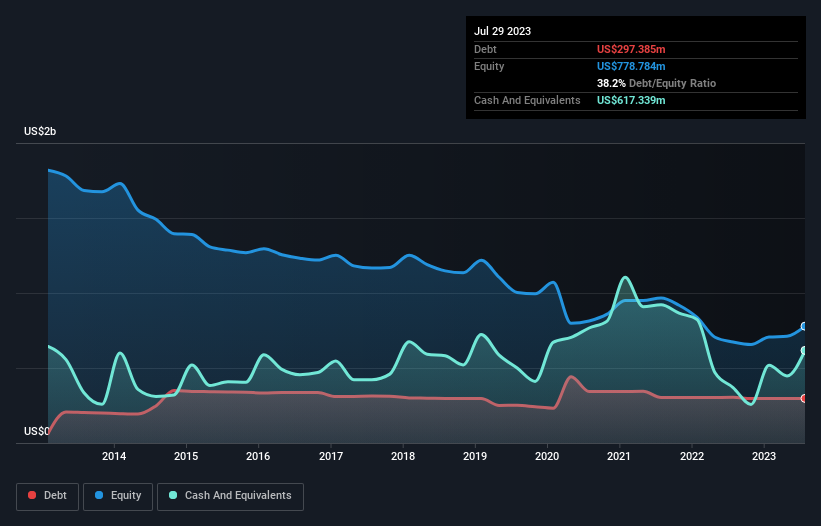- United States
- /
- Specialty Stores
- /
- NYSE:ANF
Abercrombie & Fitch (NYSE:ANF) Has A Rock Solid Balance Sheet

David Iben put it well when he said, 'Volatility is not a risk we care about. What we care about is avoiding the permanent loss of capital.' It's only natural to consider a company's balance sheet when you examine how risky it is, since debt is often involved when a business collapses. We note that Abercrombie & Fitch Co. (NYSE:ANF) does have debt on its balance sheet. But the real question is whether this debt is making the company risky.
When Is Debt A Problem?
Debt and other liabilities become risky for a business when it cannot easily fulfill those obligations, either with free cash flow or by raising capital at an attractive price. Ultimately, if the company can't fulfill its legal obligations to repay debt, shareholders could walk away with nothing. However, a more common (but still painful) scenario is that it has to raise new equity capital at a low price, thus permanently diluting shareholders. Having said that, the most common situation is where a company manages its debt reasonably well - and to its own advantage. When we examine debt levels, we first consider both cash and debt levels, together.
View our latest analysis for Abercrombie & Fitch
How Much Debt Does Abercrombie & Fitch Carry?
The chart below, which you can click on for greater detail, shows that Abercrombie & Fitch had US$297.4m in debt in July 2023; about the same as the year before. However, its balance sheet shows it holds US$617.3m in cash, so it actually has US$320.0m net cash.

How Strong Is Abercrombie & Fitch's Balance Sheet?
We can see from the most recent balance sheet that Abercrombie & Fitch had liabilities of US$936.5m falling due within a year, and liabilities of US$1.08b due beyond that. On the other hand, it had cash of US$617.3m and US$112.6m worth of receivables due within a year. So it has liabilities totalling US$1.29b more than its cash and near-term receivables, combined.
While this might seem like a lot, it is not so bad since Abercrombie & Fitch has a market capitalization of US$3.73b, and so it could probably strengthen its balance sheet by raising capital if it needed to. However, it is still worthwhile taking a close look at its ability to pay off debt. While it does have liabilities worth noting, Abercrombie & Fitch also has more cash than debt, so we're pretty confident it can manage its debt safely.
On top of that, Abercrombie & Fitch grew its EBIT by 57% over the last twelve months, and that growth will make it easier to handle its debt. The balance sheet is clearly the area to focus on when you are analysing debt. But it is future earnings, more than anything, that will determine Abercrombie & Fitch's ability to maintain a healthy balance sheet going forward. So if you want to see what the professionals think, you might find this free report on analyst profit forecasts to be interesting.
Finally, while the tax-man may adore accounting profits, lenders only accept cold hard cash. Abercrombie & Fitch may have net cash on the balance sheet, but it is still interesting to look at how well the business converts its earnings before interest and tax (EBIT) to free cash flow, because that will influence both its need for, and its capacity to manage debt. Over the most recent three years, Abercrombie & Fitch recorded free cash flow worth 67% of its EBIT, which is around normal, given free cash flow excludes interest and tax. This cold hard cash means it can reduce its debt when it wants to.
Summing Up
While Abercrombie & Fitch does have more liabilities than liquid assets, it also has net cash of US$320.0m. And it impressed us with its EBIT growth of 57% over the last year. So we don't think Abercrombie & Fitch's use of debt is risky. There's no doubt that we learn most about debt from the balance sheet. However, not all investment risk resides within the balance sheet - far from it. Be aware that Abercrombie & Fitch is showing 1 warning sign in our investment analysis , you should know about...
If you're interested in investing in businesses that can grow profits without the burden of debt, then check out this free list of growing businesses that have net cash on the balance sheet.
If you're looking to trade Abercrombie & Fitch, open an account with the lowest-cost platform trusted by professionals, Interactive Brokers.
With clients in over 200 countries and territories, and access to 160 markets, IBKR lets you trade stocks, options, futures, forex, bonds and funds from a single integrated account.
Enjoy no hidden fees, no account minimums, and FX conversion rates as low as 0.03%, far better than what most brokers offer.
Sponsored ContentNew: Manage All Your Stock Portfolios in One Place
We've created the ultimate portfolio companion for stock investors, and it's free.
• Connect an unlimited number of Portfolios and see your total in one currency
• Be alerted to new Warning Signs or Risks via email or mobile
• Track the Fair Value of your stocks
Have feedback on this article? Concerned about the content? Get in touch with us directly. Alternatively, email editorial-team (at) simplywallst.com.
This article by Simply Wall St is general in nature. We provide commentary based on historical data and analyst forecasts only using an unbiased methodology and our articles are not intended to be financial advice. It does not constitute a recommendation to buy or sell any stock, and does not take account of your objectives, or your financial situation. We aim to bring you long-term focused analysis driven by fundamental data. Note that our analysis may not factor in the latest price-sensitive company announcements or qualitative material. Simply Wall St has no position in any stocks mentioned.
About NYSE:ANF
Abercrombie & Fitch
Through its subsidiaries, operates as an omnichannel retailer in the Americas, Europe, the Middle East, Africa, and the Asia-Pacific.
Outstanding track record with flawless balance sheet.
Similar Companies
Market Insights
Community Narratives



